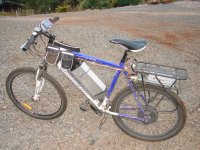
I have recently completed the conversion of a Schwimm front sprung 24 speed mountain bike to an electric powered bike.
The new mountain bike I bought was from a local store ready for the conversion it had only front suspension and rim brakes because I was unsure how I was going to complete the conversion. I paid A$350 for the bike.
Next I after looking at many posts on this forum I decided I would need a 1000W geared hub drive to give me enough torque to get up the steep hills, about 15 per cent slope, around the hilly part of Tasmania where I live.
Again searching across the net especially "Alibaba.com" I came across the Chinese seller "ebike-emsbattery.com".
On their website store they had a 1000W 48V Rear Hub Motor for US$179.00 plus US$9.80 for the 26 inch rim and US$7.80 for the spokes plus US$7.80 to mount the rim on the hub and US$5.00 for a free wheeling hub.
Having decided on the motor I then decided on their 48V 10AH LiFePO4 Aluminum Alloy Shell Battery Pack For E-Bike US$292.47 plus US$35.00 for the controller, US$5.00 for the twist grip throttle, US$24.68 for a 2A charger and plus US$20 for a rear rack for the battery.
The specs for the battery pack and controller are:-
1. Nominal voltage:51.2Volts.
2. Rated capacity @ C/3 20 ℃:10Ah
3. Lifecycle: 2000Cycles.
4. Dimension: 69mmX148mmX360mm(15Amp BMS),69mmX148mmX370mm(25Amps)
5. Operating temperature:- 20 ℃ to 60 ℃
6.Charge temperature: 0 ℃ to 45 ℃
7. Storage temperature: -20 ℃ to 45 ℃
8. Operating humidity:5% to 90%
BMS Specification:
1. Operating current: 15A(or 25A)
2. Peak current: 50A
3. Charge current:15A
4. Over-voltage protection:3.9 V
5. Under-voltage protection:2.0 V
6. Cell balancing function:Yes
7. Output port
8. Charge port:C+ / C-
Charger Specification:
1. Input: 110 or 220V AC(your country's standard)
2. Output:58.4V DC 2A
To keep an eye on the power consumption I bought their "Watt-up" power analyser for US$25.50.
As I was eager to to complete the conversion ASAP I paid US$198.00 for express air freight.
I had placed my order through their sales person Jenny Hong via e-mail.
Jenny then e-mailed me an invoice offering two methods of payment either direct electronic funds transfer or Paypal with a surcharge.
I decided to use electronic funds transfer which worked fine but there was an additional US$25.00 fee I had not taken into account so the amount deposited into their bank account was US$25.00 short so I had to amend my order taking out the free wheeling hub and going for a 2A rather than 4A charger.
Once my order was squared up with deposited funds the goods were dispatched very quickly and arrived here in Tasmania Australia super speedily in four days!
The packaging was adequate with a little damage to bike rack which had the battery mounted in it.
The assembly instructions were brief but self explanatory as the plugs/sockets for the various connectors were unique.
The only bike part I had to source locally was a free wheeling hub for the new wheel with the hub motor. This cost me A$40.00 fitted!
I also fabricated a torque arm for the new rear wheel
Myself and a friend mounted up the new rear wheel and rack in half a day and did the wiring in about the same time.
I started with the battery mounted in the rack but found that the bike was very back heavy and unstable on the steep slopes I was riding up so I mounted the battery pack in the middle of the frame as you can see in the photo.
I have been using the bike most weekends for the last six months going for about 20km on hilly terrain using about 5AH worth of power out of the battery.
The bike has proved to be just what I wanted to keep me and the dog exercised!

